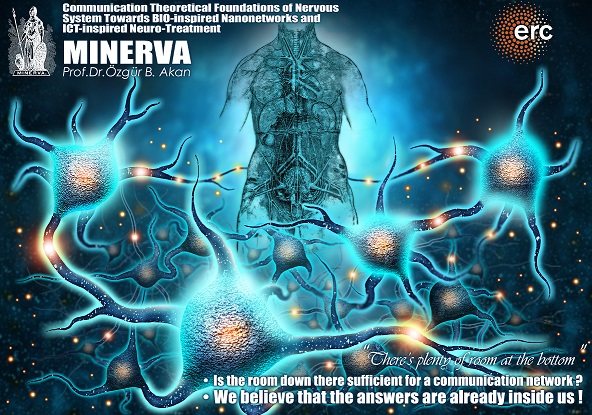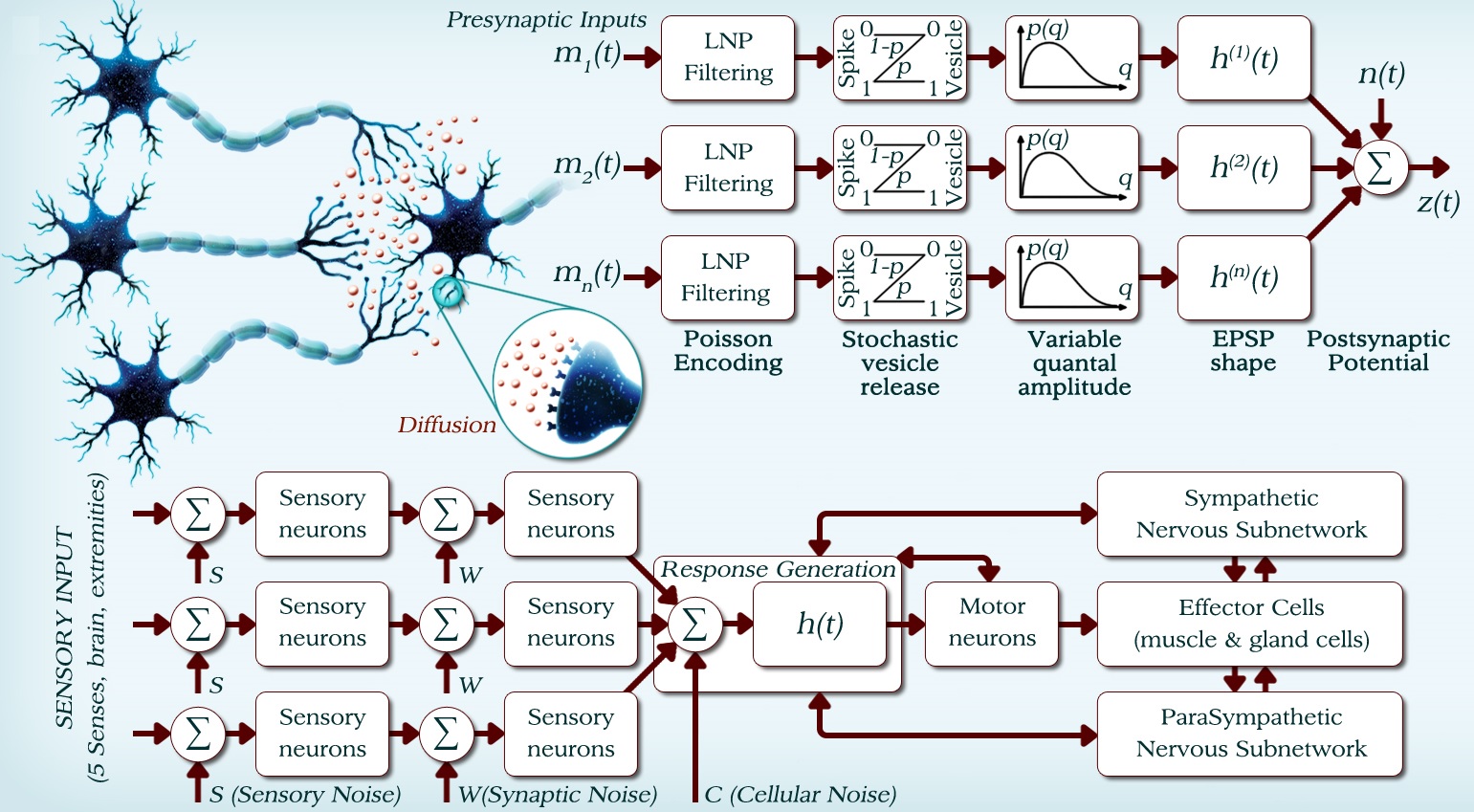MINERVA: Communication Theoretical Foundations of Nervous System Towards Bio-Inspired Nanonetworks and ICT-Inspired Neuro-Treatment
|| Funded by: ERC Consolidator Grant || Period: February 2014 - February 2019 || Amount: 1.8M Euro |
 |
“There’s Plenty of Room at the Bottom.” This statement was made by Nobel laureate physicist Richard Feynman in his famous speech describing his vision on the possibility of manipulating individual atoms and molecules to realize increasingly tinier, and yet powerful, practical man-made devices in the future. Indeed, incredible improvements in the field of nanotechnology have yielded integrated functional devices consisting of nanoscale components, i.e., nanomachines. Nanomachines used in applications today typically operate independently and accomplish tasks ranging from computing and data storing to sensing and actuation. However, enabling nanomachines to communicate with each other, and thus, form nanonetworks will help realize envisioned nanotechnology applications demanding more than the capabilities of a single device. At this point, with the encouragement of the progresses in nanotechnology, we dare to ask the question “is the room down there sufficient for a communication network?” Then, we turn to nature again, and hence, become motivated to start a quest for an answer to this profound question, which defines the main framework of the MINERVA Project and sets its objectives beyond visual boundaries.

Some applications of nanonetworks, among others, are: a number of nanomachines communicating for intelligent drug delivery; multiple nanosensors deployed on the human body to monitor glucose, sodium, and cholesterol; detecting the presence of different infectious agents. However, realization of these applications mandates addressing the unique challenges posed by the physical characteristics of nanomachines, e.g., dimensions, scarce memory and processing capabilities, and their operating environment, on the nanoscale communications.
Several communication paradigms are considered for use in nanonetworks, but the most promising is molecular communications, where molecules are used to encode, transmit and receive information. It is promising because: (i) molecular communication between nanoscale entities occurs in nature, thus, such natural phenomena offers a readymade studying ground both to model nanonetworks and to develop solutions; and (ii) several of the aforementioned applications require bio-compatibility which therefore necessitates properties that are readily offered by natural molecular nanonetworks.

The realization of molecular nanonetworks, however, demands novel engineering solutions, i.e., identification of the existing molecular communication mechanisms, development of architectures and networking techniques for nanomachines. Luckily, these engineering skills and technology have been prepared for us by the natural evolution in the last several billion years. Thus, the answers that we seek in this project are already inside us.
Indeed, the human body is a large-scale heterogeneous communication network of molecular nanonetworks as it is composed of billions of nanomachines, i.e., cells, whose functionalities primarily depend on nanoscale molecular communications. Human body systems, e.g., nervous, cardiovascular, endocrine systems, the five senses, are connected to each other and communicate primarily through molecular communications. Among the intra-body systems, the most advanced and complex one is the nervous system, which is the ultra-large scale communication network of nerve cells, i.e., neurons. The nervous nanonetwork transmits the external stimulus to the brain and enables communication between different systems by conveying information with electro-molecular impulse signal known as spike. As a complex network of nanonetworks spanning the whole body, the nervous system is the most vital communication network of human body. Any communication failure that is beyond the recovery capabilities of this network leads to serious neural diseases; e.g., multiple sclerosis (MS), Alzheimer’s disease, and paralysis. Thus, sustaining effective communication capabilities in the nervous nanonetwork is imperative for the functional and metabolic efficiency of the human body. Furthermore, understanding disorders caused by communication failures paves the way for the possible development of a new generation of information and communication technology (ICT)-inspired treatment techniques. In addition, identifying the existing nervous molecular communication mechanisms, establishing the communication and information theoretical foundations of these communication channels, will be a giant step towards developing real implementable architectures, e.g., bio-inspired communication techniques for emerging applications of nanonetworks and ICT-based prosthetic systems with neural communication capabilities.

In the MINERVA project, that has been awarded the European Research Council’s (ERC) consolidator grant, which constitutes Europe's most prestigious research funding programme, and has previously been received by many Nobel Award winning scientists, we primarily focus on nervous nanonetwork because: (i) it is the most vital and the largest intra-body nanonetwork spanning the entire body with the most advanced intrinsic communication functionalities, (ii) although extensive research efforts are directed towards understanding the mechanism of nervous system from the perspectives of physiology and neuroscience; information and communication theoretical fundamentals of the nervous nanonetwork and extraction of its intrinsic design principles to be used in future nanonetwork applications are overlooked, and (iii) there exists a vast amount of results in neurophysiology, which could be exploited by the elegant theories and tools of ICT domain.
Thus, realistically modelling the nervous molecular communication channels, analyzing and understanding its network and communication theoretical capabilities and shortcomings, and ultimately contributing to the development of bio-inspired solutions for nanonetworks and ICT-inspired solutions for neural diseases are the interdisciplinary objectives of the MINERVA project. The project will bridge the gap between communication engineering and life sciences, and create important collaboration opportunities. With the parallel progress of medical sciences and communication engineering, a major breakthrough can be expected from this exceptionally interdisciplinary approach.